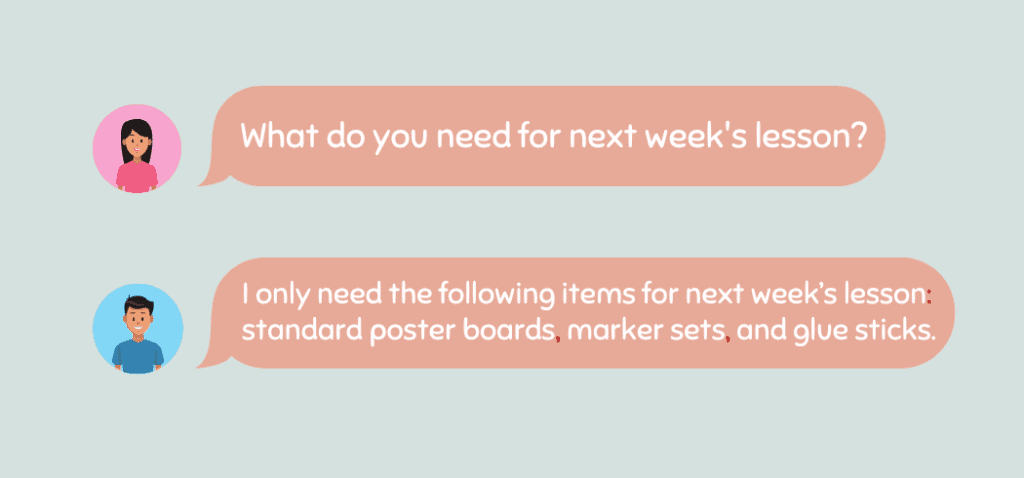The English language uses many rules to create clarity in your writing. A proper sentence format integrates more than just a capitalization and end mark; it includes punctuation marks to form complete sentences and add detail to your writing purpose.
My students avoid using colons because they assume their use is complicated. However, nothing could be further from the truth. Colons serve one purpose and have one general rule of thumb to remember: they can only follow an independent clause.
Let’s look at how colons are used, particularly how they are used with lists to create clarity.
Rules of Colon Use
There is only one rule to follow when using a colon. It must follow an independent clause (complete sentence) to direct attention to the completion of an idea, explanation, quotation, or list.
What follows after the colon must be a dependent clause.
For example
- The testing session could have been better planned out: no information provided beforehand.
- His words perfectly summed up the testing scores: “no organization, no useful results.”
- Only a few things were needed to make it successful: a schedule made in advance, communication with instructors, and an explanation to the students.
How Colons Complete an Idea
Whereas semicolons are used to combine two independent clauses to continue a thought or idea, a colon directs attention to a related thought or idea.
Essentially, they complete the idea by providing detail or a further example as an addition to the sentence.
For example
- She pondered, in frustration, about how the day could have run smoother: communication would’ve helped.
How to Use Colons for a List

A list should be introduced with a colon only when an independent clause precedes the list. This is the most common use of the colon and helps the reader visually recognize the items listed are explained in the preceding sentence.
When Colons Introduce a List in a Sentence
When you use colons to introduce a horizontal list in a sentence, you also must use it after a complete sentence.
For example
- This week could not have been more disorganized: first, no communication about testing; second, poor insurance company service; third, the flooded parking lot.
- I only need the following items for next week’s lesson: standard poster boards, marker sets, and glue sticks.
When Colons Introduce a List in Vertical Lists
It’s very popular to create bulleted, horizontal lists for easy reading. The rules of colon use are still the same no matter how you use listed items following its placement. if you place a colon before bullet points, make sure it is at the end of an independent clause.
For example
- The student café is opening next week and will sell various items:
- Panini
- Water and soda
- Dessert selections
- Salad
- In order for the school year to be successful, we need to get more organized:
- Don’t reply all
- Meeting times set 48 hours in advance
- Provide feedback
Using Colons to List Abbreviations
Abbreviations are shortened versions of longer words. You can use colons after the abbreviation to provide the full form of each.
For example
- LOL: laugh out loud
- NP: no problem
- SMH: shake my head
- OR: Oregon
Colon Mistakes to Avoid
Semicolons are used to connect two related sentences either by replacing the period between them or by replacing a comma and coordinating conjunction pair. Many people mistakenly use a colon in place of a semicolon to emphasize the second sentence.
Although colons follow a complete sentence, they are followed by lists, phrases, or dependent clauses.
When NOT to Use Colons
Don’t use colons after headings, captions, or titles. Font size, bold font, and indentation are suggestions to help format this use.
For example
Grandma’s Favorite Pie Ingredients
- Flour
- Sugar
- Eggs
- Milk
- vanilla
Brunch Tea Menu
Scones
Ham sandwiches
Cheese selection
Petit fours
Tart variety
Coffee
Tea of choice
Let’s Review
A colon is a simple punctuation mark that follows one very basic rule: it must follow a complete sentence to connect list items, phrases, or dependent clauses to the main sentence.
When a colon is used before a list, it indicates that the following list is related to the preceding sentence. Occasionally the list serves as an example of the topic of the sentence. Hopefully, these simple colon list rules help you better understand its use so you can use it to help clarify and add detail to your writing.
